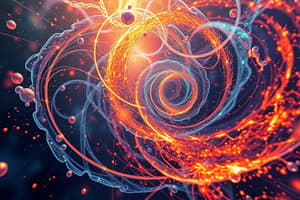Podcast
Questions and Answers
In ________ mixtures, the composition is uniform throughout, whereas in heterogeneous mixtures, the composition is non-uniform.
In ________ mixtures, the composition is uniform throughout, whereas in heterogeneous mixtures, the composition is non-uniform.
homogeneous
According to the Kinetic Molecular Theory, particles are in constant, ________ motion, which explains the diffusion and mixing of gases.
According to the Kinetic Molecular Theory, particles are in constant, ________ motion, which explains the diffusion and mixing of gases.
random
The average kinetic energy of particles is directly proportional to ________; thus, an increase in temperature signifies an increase in particle motion.
The average kinetic energy of particles is directly proportional to ________; thus, an increase in temperature signifies an increase in particle motion.
temperature
Rutherford's gold foil experiment led to the conclusion that the atom consists of a small, dense, positively charged ________ surrounded by mostly empty space.
Rutherford's gold foil experiment led to the conclusion that the atom consists of a small, dense, positively charged ________ surrounded by mostly empty space.
The ________ model of the atom introduced the concept of quantized electron orbits, where electrons can only occupy specific energy levels.
The ________ model of the atom introduced the concept of quantized electron orbits, where electrons can only occupy specific energy levels.
________ are atoms of the same element that have the same number of protons but different numbers of neutrons, leading to variations in atomic mass.
________ are atoms of the same element that have the same number of protons but different numbers of neutrons, leading to variations in atomic mass.
In mass spectrometry, the ________ axis represents the mass-to-charge ratio of the ions, which is used to determine the isotopic composition of a sample.
In mass spectrometry, the ________ axis represents the mass-to-charge ratio of the ions, which is used to determine the isotopic composition of a sample.
Electron configuration describes the arrangement of electrons within an atom, with electrons filling orbitals according to the ________ principle, Hund's rule, and the Aufbau principle.
Electron configuration describes the arrangement of electrons within an atom, with electrons filling orbitals according to the ________ principle, Hund's rule, and the Aufbau principle.
Atoms of the same element that have different numbers of neutrons are known as ______.
Atoms of the same element that have different numbers of neutrons are known as ______.
In mass spectrometry, ions are sorted based on their ______-to-charge ratio.
In mass spectrometry, ions are sorted based on their ______-to-charge ratio.
The principle that dictates filling the lowest energy orbitals first when determining electron configuration is the ______ principle.
The principle that dictates filling the lowest energy orbitals first when determining electron configuration is the ______ principle.
The exclusion principle states that a maximum of two electrons can occupy a single orbital, provided they have ______ spins.
The exclusion principle states that a maximum of two electrons can occupy a single orbital, provided they have ______ spins.
According to ______'s rule, electrons will individually occupy each degenerate orbital with parallel spins before any orbital is doubly occupied.
According to ______'s rule, electrons will individually occupy each degenerate orbital with parallel spins before any orbital is doubly occupied.
When writing the electron configuration for ions, electrons are first removed from the ______ shell.
When writing the electron configuration for ions, electrons are first removed from the ______ shell.
The Balmer series in the hydrogen emission spectrum consists of lines in the ______ region.
The Balmer series in the hydrogen emission spectrum consists of lines in the ______ region.
The rule is used to determine the filling order of orbitals, such as 4s filling before 3d.
The rule is used to determine the filling order of orbitals, such as 4s filling before 3d.
A ______ spectrum consists of distinct colored lines, such as those observed in the hydrogen emission spectrum.
A ______ spectrum consists of distinct colored lines, such as those observed in the hydrogen emission spectrum.
The average atomic mass of an element is calculated by summing the product of each ______ mass and its relative abundance.
The average atomic mass of an element is calculated by summing the product of each ______ mass and its relative abundance.
Flashcards
Element
Element
Pure substance with only one type of atom (e.g., O₂, Fe).
Compound
Compound
Two or more elements chemically bonded in fixed ratios (e.g., H₂O, CO₂).
Mixture
Mixture
Physical combination of substances not chemically bonded (e.g., air, saltwater).
Homogeneous Mixture
Homogeneous Mixture
Signup and view all the flashcards
Heterogeneous Mixture
Heterogeneous Mixture
Signup and view all the flashcards
KMT Postulate #1
KMT Postulate #1
Signup and view all the flashcards
Temperature
Temperature
Signup and view all the flashcards
Rutherford's Experiment
Rutherford's Experiment
Signup and view all the flashcards
Isotopes
Isotopes
Signup and view all the flashcards
Mass Spectra
Mass Spectra
Signup and view all the flashcards
Ionization (Mass Spec)
Ionization (Mass Spec)
Signup and view all the flashcards
Continuous Spectrum
Continuous Spectrum
Signup and view all the flashcards
Line Spectrum
Line Spectrum
Signup and view all the flashcards
Aufbau Principle
Aufbau Principle
Signup and view all the flashcards
Pauli Exclusion Principle
Pauli Exclusion Principle
Signup and view all the flashcards
Hund's Rule
Hund's Rule
Signup and view all the flashcards
Balmer Series
Balmer Series
Signup and view all the flashcards
Lyman Series
Lyman Series
Signup and view all the flashcards
Study Notes
- These notes cover the Particulate Nature of Matter, the Nuclear Atom, and Electron Configuration.
Particulate Nature of Matter
-
This includes elements, compounds, mixtures, Kinetic Molecular Theory (KMT) and Kinetic energy, and temperature.
-
Elements are pure substances that consist of only one type of atom.
-
Oxygen (O₂) and Iron (Fe)
-
Compounds contain two or more elements that are chemically bonded in fixed ratios.
-
Water (H₂O) and Carbon Dioxide (CO₂)
-
Mixtures consists of physical combinations of multiple substances that are not chemically bonded.
-
Air and Saltwater
-
Homogeneous mixtures contain uniform composition like a solution.
-
Heterogeneous mixtures contain non-uniform composition
-
Sand and Iron Filings
-
Filtration, distillation, and chromatography are separation techniques.
-
Chemical reactions are required to separate compounds, physical methods are used with mixtures.
Kinetic Molecular Theory (KMT)
- Particles are in constant, random motion.
- The volume of particles is negligible compared to the container volume.
- There are no intermolecular forces, this is an ideal gas assumption.
- Collisions are elastic, with no energy loss.
- Solids have a fixed shape and volume, where particles vibrate in place.
- Liquids have a fixed volume but variable shape where particles slide past each other.
- Gases have variable shape and volume, where particles move freely.
- Real gasses deviate at high pressure and low temperature.
Kinetic Energy and Temperature
- Temperature measures the average kinetic energy (KE) of particles.
- Average KE = (3/2) * kB * T.
- Heat is energy transfer whereas temperature is a measure of thermal energy.
- Thermal Expansion is when increased KE causes particles to vibrate/move more, leading to expansion.
- Temperature does not measure the total energy, a larger cold object can have more thermal energy than a small hot one.
Nuclear Atom
- This covers atomic models and mass spectra.
Atomic Model Evolution
- Dalton described atoms as indivisible spheres.
- Thomson proposed the "plum pudding" model with electrons in a positive cloud.
- Rutherford's gold foil experiment discovered a dense nucleus with mostly empty space.
- Bohr developed quantized electron orbits, known as the planetary model.
- The modern model describes the electron cloud (quantum mechanical model).
- Rutherford's alpha-scattering experiment showed the nucleus is small and positively charged.
Isotopes
- Isotopes are same element atoms with different numbers of neutrons.
- Carbon-12 vs. Carbon-14
- Isotopes have similar chemical behavior but different physical properties such as density and radioactivity.
- Notation: AXZ, where A = mass number and Z = atomic number.
Mass Spectra
- Mass spectra is used to determine isotopic abundance and calculation of average atomic mass.
- Process:
- Ionization turns atoms into ions.
- Acceleration sorts ions by mass-to-charge ratio (m/z).
- Detection shows peaks with abundance of each isotope.
- Average atomic mass = Σ (isotope mass × relative abundance).
- Chlorine (Chlorine-35: 75%, Chlorine-37: 25%): (35 × 0.75) + (37 × 0.25) = 35.5 u.
Electron Configuration
- This covers emission spectra and electron configuration rules.
Emission Spectra
- A continuous spectrum is white light dispersed into all wavelengths, creating a rainbow.
- A line spectrum has distinct colored lines.
- Hydrogen emission spectrum.
- The Balmer series has visible lines and transition to n=2.
- The Lyman series is UV light with transition to n=1, and the Paschen Series is IR with transition to n=3.
- Electrons emit photons when dropping energy levels.
- ΔE = hν
Electron Configuration
- Rules:
- Aufbau Principle: Fill lowest energy orbitals first.
- Pauli Exclusion: Max 2 electrons per orbital which have opposite spins.
- Hund’s Rule: Maximize parallel spins in degenerate orbitals.
- Notation:
- Orbital Order: Follow the n + ℓ rule (e.g., 4s fills before 3d).
- Carbon (Z=6): 1s² 2s² 2p².
- Chromium (Z=24): Exception → [Ar] 3d⁵ 4s¹.
- Orbital Diagrams use boxes and arrows to represent orbitals and spins.
- (e.g., 2p²: ↑↓ ↑ _)
- In ions, remove electrons from the outermost shell first
- Fe²⁺: [Ar] 3d⁶
Study Tips
- Practice Diagrams sketching atomic models, mass spectra, and orbital configurations.
- Flashcards should memorize isotope notation, KMT postulates, and electron rules.
- Complete past papers which focus on questions about separation techniques, mass spec calculations, and emission spectra.
- Mnemonic: “Sober People Don’t Forget” assists with orbital filling order (s, p, d, f).
Key Equations/Concepts to Memorize
- Average atomic mass = Σ (isotope mass × relative abundance).
- Hydrogen emission transitions (Balmer, Lyman, Paschen).
- Aufbau order up to n=4.
Common Mistakes
- Confusing mixtures and compounds.
- Forgetting Hund’s Rule in orbital diagrams.
- Misapplying isotope notation for example Carbon-14.
Studying That Suits You
Use AI to generate personalized quizzes and flashcards to suit your learning preferences.
Description
Study notes covering the particulate nature of matter, the nuclear atom, and electron configuration. Key concepts include elements, compounds, mixtures, and the Kinetic Molecular Theory (KMT). Learn about separation techniques such as filtration, distillation, and chromatography.




